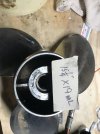Delray
Active Member
We recently purchased a boat, when looking at the printout I saw that the engines had NEVER been over 5000 rpm. Took it for a spin ( two people, half tank ) ran fine, on plane quick, wot never got above 5000.
Took it to my mechanic who was surprised as well. Now, I’m not a go fast guy, I like 25-30 mph, so at first look it doesn’t really bother me. Mechanic says they should be around 54-55 hundred if loaded like we were,( which we be 99% of the time). I realize that one doesn’t want to lug the engines, but as I said, 99% of the time it will be the two of us, and I will not be running into the 5000‘s.
So my question is
1: just how important is it have “ideal” rpm’s at wot if your never going to reach that anyway?
im sure other questions will pop up.
BTW. Engines are 150 yammies 600 ish hours
thanks.
Took it to my mechanic who was surprised as well. Now, I’m not a go fast guy, I like 25-30 mph, so at first look it doesn’t really bother me. Mechanic says they should be around 54-55 hundred if loaded like we were,( which we be 99% of the time). I realize that one doesn’t want to lug the engines, but as I said, 99% of the time it will be the two of us, and I will not be running into the 5000‘s.
So my question is
1: just how important is it have “ideal” rpm’s at wot if your never going to reach that anyway?
im sure other questions will pop up.
BTW. Engines are 150 yammies 600 ish hours
thanks.


